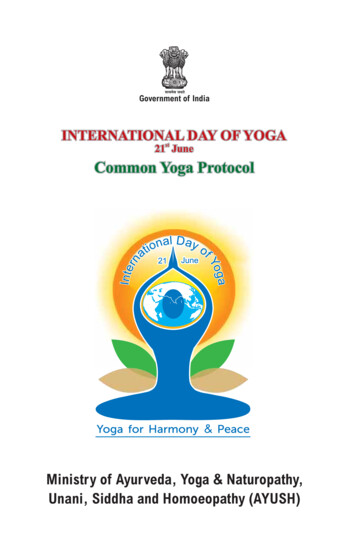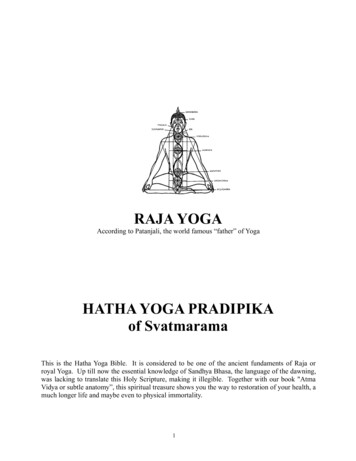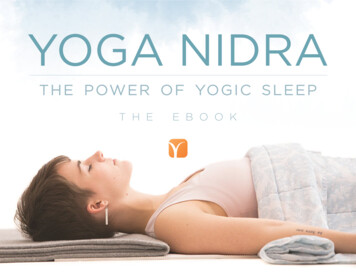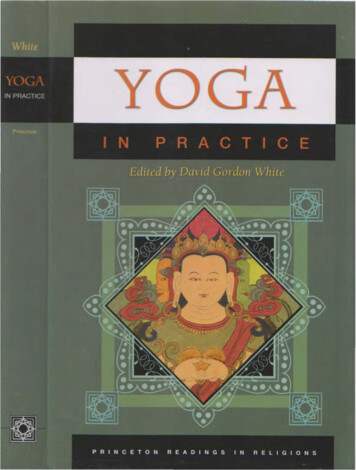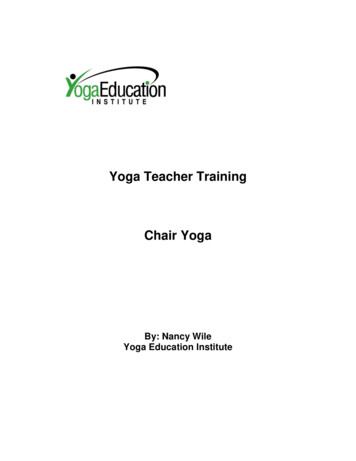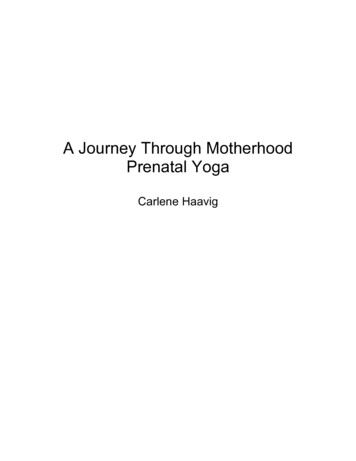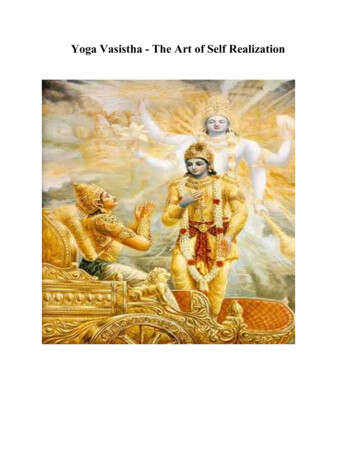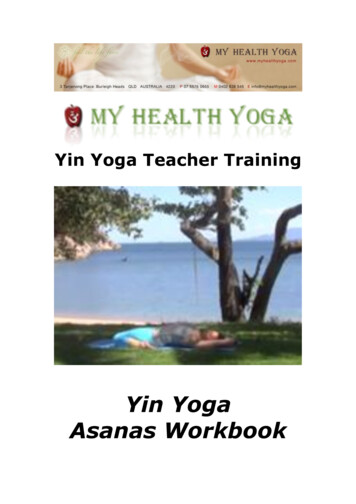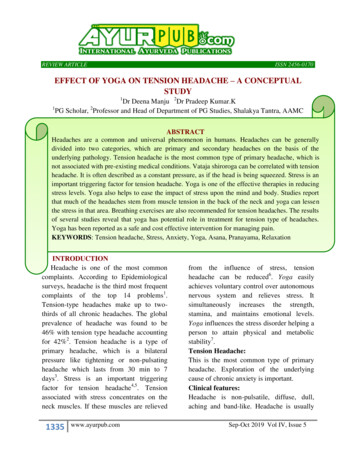
Transcription
REVIEW ARTICLEISSN 2456-0170EFFECT OF YOGA ON TENSION HEADACHE – A CONCEPTUALSTUDY1Dr Deena Manju 2Dr Pradeep Kumar.K1PG Scholar, 2Professor and Head of Department of PG Studies, Shalakya Tantra, AAMCABSTRACTHeadaches are a common and universal phenomenon in humans. Headaches can be generallydivided into two categories, which are primary and secondary headaches on the basis of theunderlying pathology. Tension headache is the most common type of primary headache, which isnot associated with pre-existing medical conditions. Vataja shiroroga can be correlated with tensionheadache. It is often described as a constant pressure, as if the head is being squeezed. Stress is animportant triggering factor for tension headache. Yoga is one of the effective therapies in reducingstress levels. Yoga also helps to ease the impact of stress upon the mind and body. Studies reportthat much of the headaches stem from muscle tension in the back of the neck and yoga can lessenthe stress in that area. Breathing exercises are also recommended for tension headaches. The resultsof several studies reveal that yoga has potential role in treatment for tension type of headaches.Yoga has been reported as a safe and cost effective intervention for managing pain.KEYWORDS: Tension headache, Stress, Anxiety, Yoga, Asana, Pranayama, RelaxationINTRODUCTIONHeadache is one of the most commoncomplaints. According to Epidemiologicalsurveys, headache is the third most frequentcomplaints of the top 14 problems1.Tension-type headaches make up to twothirds of all chronic headaches. The globalprevalence of headache was found to be46% with tension type headache accountingfor 42%2. Tension headache is a type ofprimary headache, which is a bilateralpressure like tightening or non-pulsatingheadache which lasts from 30 min to 7days3. Stress is an important triggeringfactor for tension headache4,5. Tensionassociated with stress concentrates on theneck muscles. If these muscles are relieved1335www.ayurpub.comfrom the influence of stress, tensionheadache can be reduced6. Yoga easilyachieves voluntary control over autonomousnervous system and relieves stress. Itsimultaneously increases the strength,stamina, and maintains emotional levels.Yoga influences the stress disorder helping aperson to attain physical and metabolicstability7.Tension Headache:This is the most common type of primaryheadache. Exploration of the underlyingcause of chronic anxiety is important.Clinical features:Headache is non-pulsatile, diffuse, dull,aching and band-like. Headache is usuallySep-Oct 2019 Vol IV, Issue 5
Deena Manju et. al ; Effect of Yoga on Tension Headache – A Conceptual Studymore in occipital and cervical region.Patientsoftencomplainofpoorconcentration and other vague nonspecificsymptoms.Aggravating factors: Headache is constantdaily and may be exacerbated by emotionalstress, fatigue, noise or glare. It gets worseon touching scalp (peri cranial tenderness).Treatment:Aspirin, acetaminophen or NSAID’S areeffective in occasional mild headache.Amitriptyline is most effective prophylacticmedicine for tension-headache8.Anti-migrainous agents are prescribed whensimple analgesics are not effective.Relaxation techniques: The massage, hotbaths and biofeedback are helpful9,10.Botulinum toxin type A: Local injectionmay be useful11.Some of the triggers for headaches areStress, lack of sleep, hunger, allergies, sinusproblems or eye strain. But posture, and alack of oxygen, could bring on headaches.Many people sit or stand with roundedshoulders and head jutted forward. Poorposture can affect respiratory system andblood circulation to the brain; which cancause muscle tension, resulting in aheadache.If headaches arise from tension, then yogacan be considered. Yoga helps to ease thetension headaches by relaxing muscles inhead, back, and neck, boosting circulation tobrain and upper body, and improving theposture. The best time to treat a headache isat the first sign of the pain, before themuscles go into spasm. To reduce theamount of headache, following yoga posescan be incorporated in daily na,pranayama’s can be advised in tensionheadache12,13:1) Neck Movement: Forward- Backwardand Sideways and Rotation:Sukshma vyayama mainly concentrates onneck movements. Neck movements withrhythmical breathing which includes theforward and backwards bending, sidebending, lateral bending, and clockwise andanticlockwise rotation of the head. Duringthe start of each neck movement patientinhales and exhales when returning tonormal pose. Patient breathes normally inthe final position. All movements areperformed in standing position with eyesclosed and with slow breathing. Each neckmovement has to be performed 5 times andthe duration taken will be 5 minutes.2) Yogasanas or yogic postures are typicalphysical postures of the body where indifferent muscles get simultaneouslystretched and relaxed.Asana postures beneficial in tensionheadache are supta matsyendrasana, triyakabhujangasana and shavasana.These asana are done mainly withconcentration on neck muscles and backmuscles.a) Supta matsyendrasana:Patient is allowed to lie in supine positionwith eyes closed with normal breathing. Thehands are placed sideward on the floor at thelevel of shoulders. Both legs are slowlySep-Oct 2019 Vol IV, Issue 5
Deena Manju et. al ; Effect of Yoga on Tension Headache – A Conceptual Studyfolded at the knees and then bend the kneesto right side. Simultaneously the neck is bentto the left side. This is repeated on theopposite side.b) Triyaka bhujangasana:Patient is allowed to lie in prone positionwith eyes closed with normal breathing.Legs are brought together slowly and thepalms are placed on either side of the chest.The head and chest are slowly raised andwhile inhaling head is slowly turned towardsthe right side. This is done on the other sidealso. Each asana is performed for 30seconds on each side. This is practiced for 4min and in between two asanas, person isallowed to relax for 1 min.c) Shavasana:Patient is allowed to lie down in supineposition with eyes closed with normalbreathing. Patient is taught the modifiedspecial breathing technique which involvesselection of numbers from sixty andcounting the number in reverse manner up toone, wherein with every counted numberdeep inhalation and forceful exhalation isdone. This is practiced for one to two times.The procedure takes 20 minutes.d) Makarasana:1337www.ayurpub.comPatient is made to lie in prone positionkeeping the leg close to each other withsoles facing upward, hands sideward withpalms on the ground and chin touching theground. Widen both feet about half a meterapart with heals inward and touching theground. Bending the right elbow, place theright palm on the left shoulder. In the samepattern, keep the left palm on the rightshoulder. Support the neck at the crossingpoint of the hands. Relax with eyes closed.Maintain this position for two minutes andslowly return to the original position. Byperforming this asana, the vital centers inthe brain get sufficient rest.3) Pranayama: As pranayama has a greaterbeneficial effect on the nervous system,mind becomes calm and quiet and mentaltranquility is sought. Mental tranquilityreduces the mental stress and strain.Some of the pranayama types which arebeneficial in tension headache are:a) Sitkari, Cooling Breath:Technique: Gently open mouth, keeping theupper and lower teeth touching each otherand inhale through mouth with a hissingsound. Then performing kumbhaka (breathretention) with bandhas and exhale throughnostrils. This pranayama helps to calm themind and emotions.Sep-Oct 2019 Vol IV, Issue 5
Deena Manju et. al ; Effect of Yoga on Tension Headache – A Conceptual Studyb) Nadibreathing:Shodhana,AlternatenostrilTechnique: Sit comfortably and close theeyes. Place the index and middle fingers ofthe right hand between the eyebrows so thatthe ring and little fingers rest on the leftnostril and the thumb on the right. Start byclosing the right nostril with the thumb andexhaling through the left nostril. Breath inthrough the left nostril, pressing it closedbefore opening the right nostril andbreathing out. Repeat with long, deepsmooth breaths. Nadishodhana managesstress and also overcome many symptomsthat results from chronic stress.DISCUSSIONYoga is very beneficial in treating tensionheadache. Since olden days, yoga is used forimproving health. To cure differentailments, yoga has been practiced in severalcountries, particularly related to mentalstress14. Studies have shown that chronicpain goes beyond the nociceptive pathwayand has a negative effect on various otheraspects of a person's life. Yoga hasdocumented good clinical outcome intreating patients with Migraine as well astension headache.Muscle relaxation techniques like; listeningto music has shown to reduce anxiety. Stresscan produce spasms by interfering withcoordination of different muscle groupsinvolved in the functioning of neck.In a study, the Yoga-based guided relaxationwas shown to reduce sympathetic activity as1338www.ayurpub.commeasured by autonomic parameters, oxygenconsumption, and volume of breaths. Yogaasana has been found to act on disorderswith lower levels of gamma-aminobutyricacid (GABA)-like depression and anxiety.Hatha yoga promotes physical relaxation bydecreasing activity of sympathetic nervoussystem, which lowers heart rate andincreases breathe volume. The effect ofstress is mainly deposited in the neckmuscles; muscle relaxation attained throughstretching of neck muscles was the main aimin practicing of asana for reduction of painand stiffness in neck muscles. A deepbreathing exercise provides extra oxygen tothe blood and causes the body to releaseendorphins, which are naturally occurringhormones that reenergize and promoterelaxation15. Yoga asana and relaxationtechniques help in the reduction of anxietylevels and treated as a complimentarytherapy16. The decreased peripheral nervoussystem (PNS) and GABAergic activity thatunderlies stress-related disorders can becorrected by yoga practices resulting inamelioration of disease symptoms that occurdue to the underlying stress17.Various studies which have concluded thatyoga decreases nuchal rigidity, increasesendorphins, and GABAergic activity provethat yoga reduces tension18.CONCLUSION-Yoga is interrelated with physical, mentaland spiritual healings; thereby it reducesstress and anxiety.-By doing Yoga one can attain physical andmetabolic stability.-The results of several studies reveal thatyoga has potential beneficial role intreatment for tension type of headache.Sep-Oct 2019 Vol IV, Issue 5
Deena Manju et. al ; Effect of Yoga on Tension Headache – A Conceptual Study-Yoga is a safe and cost-effectiveintervention for managing pain and reducingstress levels.-Yoga namely asana, breathing exercisesand relaxation techniques are beneficial ontension headache.-Yoga has proved to be a boon to humanityin this modern stress-age.REFERENCES1. https://www.ncbi.nlm.nih.gov/pubmed/21 965970 16-03-2019 12:05:00.2. Stovner Lj, Hagen K, Jensen R, KatsaravaZ, Lipton R, Scher A, et al. The globalburden of headache: A documentation ofheadacheprevalenceanddisabilityworldwide. Cephalgia 2007; 27:193-210.3. Headache Classification Committee ofInternational Headache Society. Theinternational Classification of HeadacheDisorders. 2nd edn., vol 24. Cephalalgia.Boston: Blackwell Publishing; 2004. p. 1160.4. https://www.ncbi.nlm.nih.gov/pubmed/11437890 18-03-2019 09:10:005. https://www.ncbi.nlm.nih.gov/pubmed/8349473 18-03-2019 10:05:006. Tekur P, Singphow C, Nagendra HR,Raghuram N. Effect of short-term intensiveyoga program on pain, functional disabilityand spinal flexibility in chronic low backpain: A randomized control study. J AlternComplement Med 2008; 14:637-447. Udupa KN, Singh RH, Dwivedi KN,Pandey HP,RaiV.Comparativebiochemical studies on meditation. Indian JMed Res 1975; es/ features/treatments-tension 1703-2019 /headaches/art-20047631 17-03-2019 tructions/000421.htm17-03-2019 11974977/ 17-03-2019 11:30:0012. Prof. Satyendra Prasad Mishra, Yogaand Ayurveda, Published by ChaukhambhSanskrit sansthan, Varanasi. Edition 2004.p.14113. BKS Iyengar, Light on Yoga, NewDelhi. Edition 2000. p.100, 422, 445 and452.14. ibid. 8, p.15115. https://www.ncbi.nlm.nih.gov/pubmed/17532734 22-03-2019 11:03:0016. Carlson BE, Larkin H. Meditation as acoping intervention for treatment ofaddiction. J Relig Spiritual Soc Work 2009;28:379-92.17. Marefat M, Peymanzad H, Alikhajeh Y.The Study of the effects of yoga exerciseson addicts' depression and anxiety inrehabilitation period. Procedia-Soc BehavSci 2011; 30:1494-8.18. https://www.ncbi.nlm.nih.gov/pubmed/21965970 23-03-2019 13:06:00CORRESPONDING AUTHORDr Deena ManjuPG Scholar, Department of PG Studies inShalakya Tantra , AAMC.Email: dr.deenamanjushetty29@gmail.comSource of support: Nil,Conflict of interest: None DeclaredCite this article asDeena Manju: Effect of Yoga on TensionHeadache – A Conceptual Study; ayurpub;IV(5): 1335-1339Sep-Oct 2019 Vol IV, Issue 5
EFFECT OF YOGA ON TENSION HEADACHE . STUDY 1Dr Deena Manju 2Dr Pradeep Kumar.K 1PG Scholar, 2Professor and Head of Department of PG Studies, Shalakya Tantra, AAMC important triggering factor for tensio INTRODUCTION Headache is one of the most common . Patient is allowed to lie in prone position with eyes closed with normal breathing.
